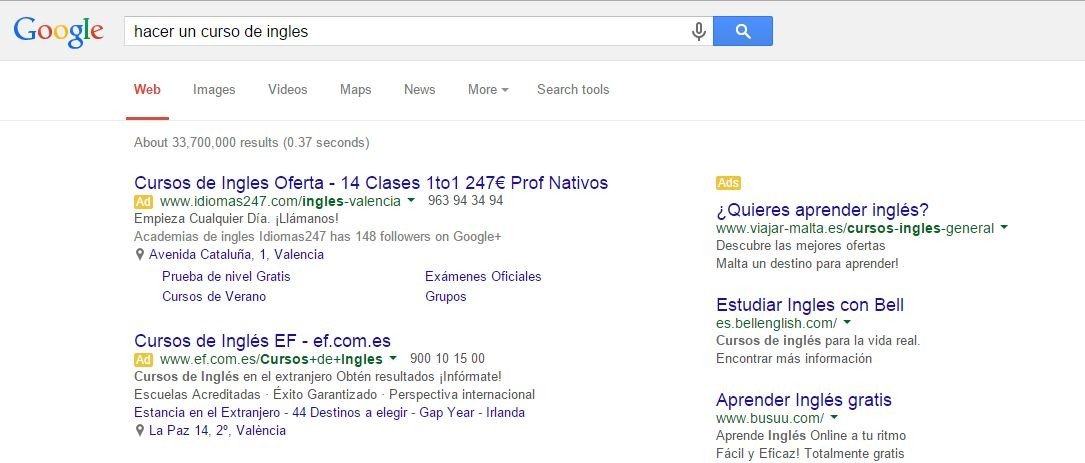Red de búsqueda o red de display: cúal usar en campañas de Adwords
Quiero hacer campañas de AdWords pero, ¿en qué Red, Búsqueda o Display?
Una vez decidimos hacer publicidad con campañas de AdWords, suele ocurrir que nos damos de bruces con distintas redes y tipos de campañas sin saber cómo elegir la que mejor se adapta a nuestros objetivos. ¿Debo hacer campañas de Red de Búsqueda? ¿O tal vez Red de display? Quizás puedas hacer ambas. Pero… ¿Van a ser todas igual de eficaces para lograr mis objetivos? ¿Puedo integrar cualquier tipo de campaña dentro de mi estrategia de marketing?
Lo cierto es que todas y cada una de las posibilidades que nos ofrece AdWords pueden ayudarnos a lograr nuestros objetivos de marketing. Sin embargo, saber elegir el tipo de campaña o la combinación de diferentes tipos de campañas de AdWords que mejor se adapten a nuestro modelo de negocio, a nuestro producto y a nuestro público marcará la diferencia.
El objetivo de este post es definir las dos grandes Redes de Publicidad de Google y cómo puede cada una de ellas llevarnos hacia la consecución de nuestros objetivos de marketing.
A continuación, introduciremos los aspectos clave de estas diferentes redes de publicidad.
Tipos de Redes o cómo elegir entre Búsqueda y Display
-
Red de Búsqueda:
Como podemos deducir por su nombre, es la que se integra en un buscador, ya sea el de Google, buscadores partners o socios de Google, como Ask o AOL, o propiedades de Google como es Google Maps.
Utilizando la Red de Búsqueda los anuncios de nuestras campañas de AdWords se mostrarán junto a resultados orgánicos cuando un usuario realice una consulta en algún buscador, siendo necesario que los términos de búsqueda introducidos coincidan o concuerden con las palabras clave que utilizamos nosotros en nuestra campaña.
De este modo si, por ejemplo, anunciamos cursos de idiomas utilizando la palabra clave «curso de inglés», nuestro anuncio será apto para mostrarse con términos de búsqueda como «cursos de inglés» o «hacer un curso de inglés», entre otros.
Por tanto, un factor clave a la hora de configurar este tipo de campañas serán las palabras claves que selecciones, pues estas van a influenciar en el coste de tu campaña. ¿A qué se debe esto?
Tendremos que identificar palabras clave con intención de compra, es decir, aquellas palabras que los usuarios introducen en Google cuando están buscando activamente para comprar algo, y que finalmente consiguen que realicen esa compra. Además, será importante saber qué términos de búsqueda utilizan los usuarios para referirse a nuestros productos, para de esta manera poder introducir nuestras palabras clave.
Aquí te decimos como elegir las palabras clave adecuadas para tus campañas https://www.digitalmenta.com/blog/como-elegir-palabras-clave-seo/
¿Cuándo conviene utilizar la Red de Búsqueda en campañas de AdWords?
La Red de Búsqueda es idónea para captar la demanda. Así pues, las campañas de AdWords en la red de búsqueda nos permitirán atraer a aquellos usuarios que se encuentran buscando de forma proactiva aquello que nosotros ofrecemos.
Además, la Red de Búsqueda suele ofrecer mejor rendimiento en cuanto a resultados y normalmente es más efectiva a la hora de conseguir conversiones, es decir, lograr que el usuario realice la acción para la que se creó la campaña. Una conversión puede ser una compra, un registro o una solicitud de información, entre otras acciones. Esto se relaciona estrechamente con lo que mencionábamos anteriormente: El usuario ya está buscando activamente el producto o servicio, por lo que estará más predispuesto a realizar una compra cuando se le muestre nuestro anuncio. Por tanto, lo más efectivo será asegurarnos aparecer siempre que algún usuario introduzca el nombre de nuestro producto o servicio, o cualquier término relacionado con este.
Además, una de las ventajas de los anuncios en las campañas de la Red de Búsqueda, es que el anunciante sólo pagará si se hace clic en el anuncio (Coste por Clic). En caso contrario, no supondrá ningún coste para el anunciante.
-
Red de Display:
Es el turno ahora de la Red de Display de Google, esta está formada por más de dos millones de lugares como páginas webs, vídeos, e incluso apps en los que pueden aparecer nuestros anuncios. En este tipo de anuncios, generalmente el anunciante paga por las impresiones que reciben sus anuncios, aunque también existe la alternativa de recurrir al Coste por Clic o CPC.
¿En qué tipo de estrategias podemos utilizar la Red de Display?
Como mencionábamos anteriormente, la Red de Display abarca millones de sitios web afiliados al programa de publicidad AdSense: portales de noticias, blogs, YouTube, GMail, aplicaciones móviles…, es decir, un gran número de ubicaciones de muy variadas temáticas en las que pueden aparecer nuestros anuncios.
Por tanto, que nuestros anuncios aparezcan en un sitio web o en otro dependerá de la temática del sitio. Es decir, podemos segmentar nuestros anuncios por palabras clave o por temas e intereses, de modo que cuando nuestra segmentación coincida con la temática del sitio web, nuestro anuncio será apto para aparecer y se mostrará en dicho sitio.
Si quieres conocer más acerca de la configuración y segmentación de la Red de Display, puedes leer este interesante artículo.
Por otra parte, la Red de Display nos permite anunciarnos con una gran variedad de formatos de anuncio: Banners estáticos, banners generados dinámicamente, con anuncios de vídeo y también con anuncios de texto.
En este este artículo podrás conocer con más detalle todos los formatos de banners para display.
Si antes hemos definido a la Red de Búsqueda como una estrategia idónea para captar la demanda, los anuncios en la Red de Display nos ayudarán a generar esta demanda. Podemos llegar a aquellas personas que estén interesadas en lo que ofrecemos pero que, quizás, no sean conscientes todavía de ello o no tengan una actitud activa de búsqueda, por lo que podemos conseguir una difusión importante.
Así pues, la Red de Display nos permite mostrar anuncios a nuestro público objetivo sin necesidad de que sean ellos los que nos busquen. De esta forma, podemos llegar a los usuarios cuando estén leyendo acerca de productos o servicios como los nuestros, o relacionados con ellos, o navegando en páginas que guardan relación con los públicos que tenemos segmentados.
-
Red de Búsqueda con expansión de Display
¿Aún no sabes cuál elegir? Tal vez tu objetivo se adapte más a una campaña en la Red de Búsqueda con expansión de Display.
Las campañas de este tipo son una opción recomendada para anunciantes en AdWords que consigan un número elevado de conversiones en sus campañas de búsqueda, ya que permite llegar a una audiencia más amplia que la simple campaña de búsqueda. Esto es debido a que sus anuncios se muestran tanto en la Red de Búsqueda como en la Red de Display.
Por esto, se aconseja esperar a que nuestra campaña de sólo búsqueda tenga un buen rendimiento y cierto nivel de conversiones diarias para cambiar su configuración a << Búsqueda con extensión de Display>>. Si por el contrario no nos funciona este tipo de campaña, siempre podremos volver a la opción de sólo búsqueda.
La diferencia en este tipo de campaña respecto a una campaña de sólo Búsqueda o sólo Display está en el formato de anuncio que puedes mostrar a tu usuario. De esta manera, con este tipo de publicidad puedes usar anuncios de texto, de imagen estática, rich media o vídeo integrado. Este tipo de anuncios aparecerán tanto en la Red de Búsqueda de Google como en los portales y páginas web que estén asociados a la Red de Display de Google.
En resumen, con los objetivos claros, resulta tarea sencilla elegir qué Red nos ayudará con cada uno. Ahora tendremos que dedicar algo de tiempo a otro cometido: elegir tipos de campaña de AdWords.
¿Todavía quieres saber más? Despeja todas tus dudas acerca de las diferencias entre la Red de Búsqueda y la de Display en este enlace
Y si quieres estar al día de todas las novedades en Marketing Digital sigue de cerca el blog de Digital Menta donde compartimos siempre nuestros descubrimientos y más ????





